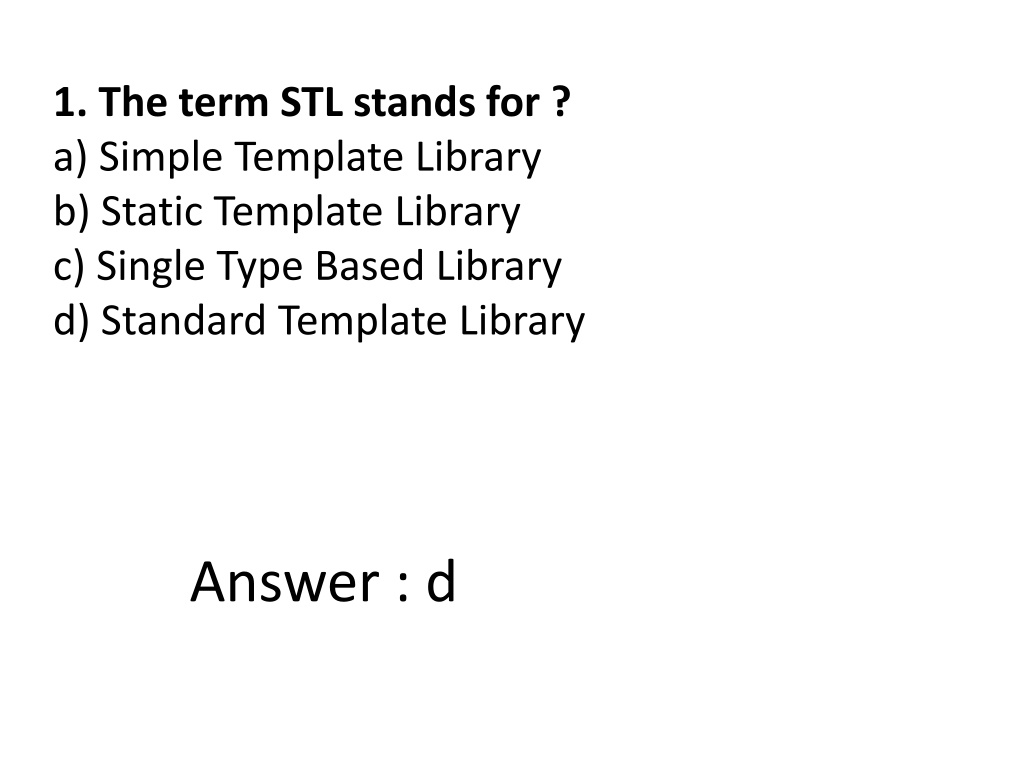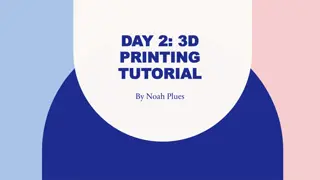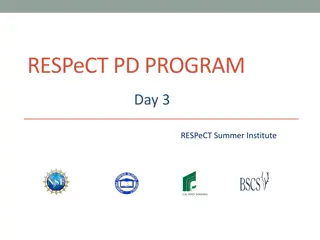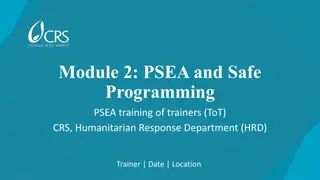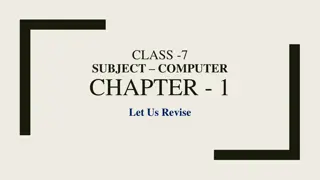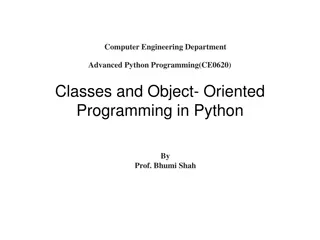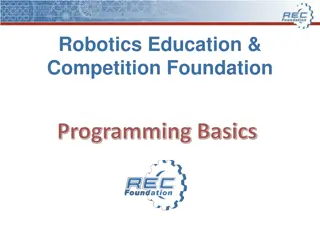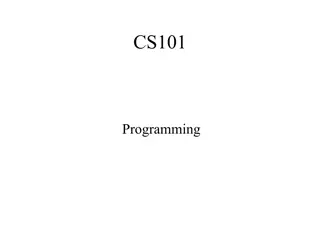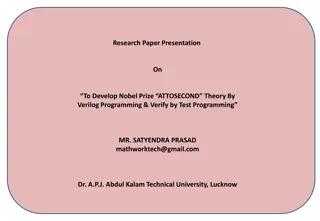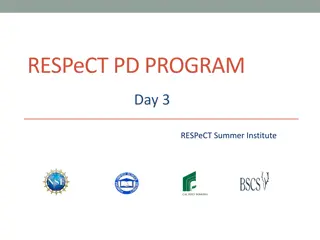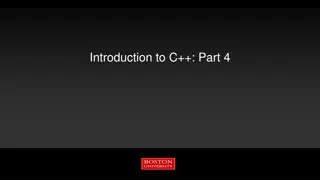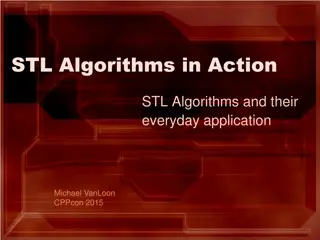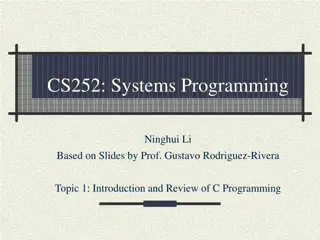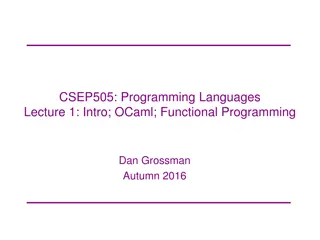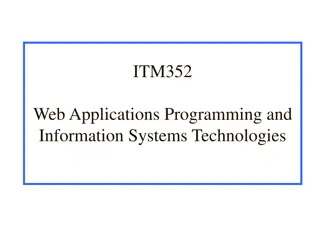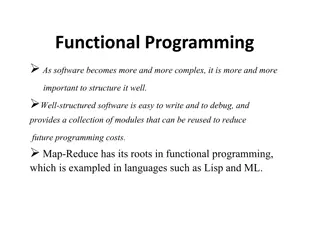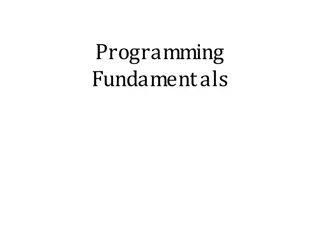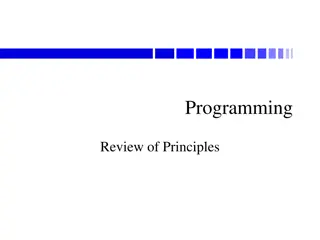STL in C++ Programming
Explore the Standard Template Library (STL) in C++ through a series of questions covering topics such as the design, iterators, data structures, vectors, and more. Learn about important concepts and functionalities related to containers, algorithms, and iterators in STL.
Download Presentation

Please find below an Image/Link to download the presentation.
The content on the website is provided AS IS for your information and personal use only. It may not be sold, licensed, or shared on other websites without obtaining consent from the author.If you encounter any issues during the download, it is possible that the publisher has removed the file from their server.
You are allowed to download the files provided on this website for personal or commercial use, subject to the condition that they are used lawfully. All files are the property of their respective owners.
The content on the website is provided AS IS for your information and personal use only. It may not be sold, licensed, or shared on other websites without obtaining consent from the author.
E N D
Presentation Transcript
1. The term STL stands for ? a) Simple Template Library b) Static Template Library c) Single Type Based Library d) Standard Template Library Answer : d
2. Which of the following statements regarding the design of the Standard Template Library (STL) in C++ is (are) true? I. Each STL algorithm is usable with one specific container. II. The STL does not use templates and instead relies on polymorphism. (a) None (b) II only (c) I and II (d) I only Answer : a
3. For an STL iterator it, execution of the statement it--; does which of the following? (a) Decreases by 1 the size of the container pointed to by it. (b) Post-decrements the item to which the iterator points. (c) Pre-decrements the item to which the iterator points. (d) Steps the iterator backwards to the previous item. Answer : d
4. Which of the following data structures is not a container implemented in the C++ Standard Template Library? (a) List (b) Hash table (c) Vector (d) Stack Answer : b
5. Consider the following C++ program fragment. vector<int> A(10); A.push_back( 5000 ); At the end of an execution of this fragment, the size of vector A is (a) 5000 (b) 0 (c) 1 (d) dependent on machine and compiler Answer : c
6In STL vectors, _____ refers to the maximum number of items that can be stored without resizing, and _____ refers to the number of items stored. (a) range, domain (b) capacity, size (c) size, capacity (d) domain, range Answer : b
7Consider the following program fragment that calls the method count_if in the C++ Standard Template Library. deque<int> numbers; ... count_if(numbers.begin(), numbers.end(), is_odd); Which of the following declarations for the method is_odd is correct for the call to count_if? (a) bool is_odd(int i); (b) bool is_odd(int begin, int end); (c) int is_odd(int begin, int end); (d) int is_odd(bool i); Answer : a
8Consider the execution of the following. vector<int> A(10,20); Which of the following accurately describes what is created? (a) An array of 20 arrays of ints, each of size 10 (b) An array of ints, indexed from 10 to 20 (c) An array of 10 arrays of ints, each of size 20 (d) An array of 10 ints, each initialized to 20 Answer : d
9Which of the following statements is (are) true regarding strings in C++? I. Strings in C++ are supported by the standard class string. II. A constructor for the class string can accept a C- style string as an argument. (a) None (b) II only (c) I and II (d) I only Answer : c
10Consider the following C++ program fragment, which is a partial declaration of the class string. class string { public: string(const char* cstring = ""); bool operator== (const string & rhs); ... }; Given this class and two string objects called s1 and s2, which of the following is not a legal statement? (a) bool ans = (s2 == "hello"); (b) string s3("Hello, World"); (c) bool ans = ("hello" == s1); (d) bool ans = (s1 == s2); Answer : c
11The main abstractions of the Standard Template Library include which of the following? I. Iterators II. Exception handlers III. Algorithms (a) III only (b) I only (c) I and II only (d) I and III only Answer : d
12 In the STL, common algorithms are instantiated for multiple types of container classes by using _____ to provide a uniform interface between the algorithms and containers. (a) arrays (b) virtual functions (c) iterators (d) pointers Answer : c
13The class vector in the C++ STL contains which of the following methods? push_back push_front pop_front (a) I and II only (b) I only (c) I, II, and III (d) II and III only Answer : b
14If A is an STL vector, then the effect of executing the statement A.push_back( x ); is to (a) append x to A if there is room, and otherwise overwrites the currently last element of A (b) append x to A if and only if the size of A is less than capacity of A (c) check whether the capacity of A is larger than the size of A, enlarges A if necessary, and append x to A (d) append x to A, without checking the size and capacity of A Answer : c
15If A is an STL vector, then the effect of executing the statement A[i] = x; is to (a) check array bounds, enlarge the vector if necessary, and then write x to position i (b) check array bounds, and write x to position i if and only if i is in the proper range (c) write x to position i of the vector, without bounds checking (d) create an iterator x pointing to position i in the array Answer : c
16 For an STL iterator it, execution of the statement ++it; does which of the following? (a) Post-increments the item to which the iterator points. (b) Advances the iterator to the next item. (c) Pre-increments the item to which the iterator points. (d) Increase by 1 the size of the container pointed to by it. Answer : b
17 Access to ranges of elements in an STL container is typically handled by (a) references (b) pointers (c) iterators (d) suitable access member functions Answer : c
18 In the C++ Standard Template Library, vectors and deques differ in their interfaces for handling which of the following operations? I. Insertion of an element at the front of the container II. Insertion of an element at the end of the container III. Removal of an element from the front of the container (a) III only (b) I and II only (c) I and III only (d) I only Answer : c
19 The STL deque container contains which of the following methods? push_back push_front pop_front (a) II and III only (b) III only (c) I only (d) I, II, and III Answer : d
20 The size of an STL vector is defined to be the (a) total of the sizes of the data members in the vector class (b) number of bytes the vector occupies in memory (c) maximum number of elements that can be stored in the vector without resizing (d) number of elements currently stored in the vector Answer : d
21Consider the following declaration that makes use of a user-defined class Thing. vector<Thing> A(10); In order that it compile, the class Thing must have which of the following? (a) a destructor (b) an assignment operator (c) a copy constructor (d) a default constructor Answer : d
22Execution of which of the following statements sets an STL iterator it so that it points to the first element of a container A? (a) A.reset( it ); (b) A.begin( it ); (c) begin( A, it ); (d) it = A.begin(); Answer : d
23The STL is heavily based on (a) polymorphism (b) inheritance (c) templates (d) object oriented programming Answer : c
24The capacity of an STL vector is defined to be the (a) difference between the current number of elements and the maximum number of elements (b) maximum number of elements that can be stored in the vector without resizing (c) number of elements currently stored in the vector (d) maximum number of elements the vector could possibly have on the given machine Answer : b
25Name of the deque class comes from: (a)the acronym "Double Ended QUEue (b) the acronym "Dynamically Extended QUEue (c) the acronym "Discrete Elements, Quantised Under Extension (d ) the name of woman who invented it: Marie Alper n de Qu Answer : b
26Iterators which can move freely any number of steps in one operation are called ---------? a) input iterators b) forward iterators c) random access iterators d) output iterators Answer : c
27There are --------types of sequence containers in the STL.? a)two b) four c) Eight d) three Answer : d
28An STL container can be used to a. hold objects of class employee. b. store elements in a way that makes them quickly accessible. c. organize the way objects are stored in memory. d. All of above Answer : d
29 The STL sequence containers are v_______, l_______, and d________. a. Vector , list, dequeu b. Vector , List, dequeue c. Vector, List, deque d. None Answer : c
30 Two important STL associative containers are s_______ and ma_______. a. Sort , Map b. Set, Map c. Standard Set, Map d. None Answer : b
31An STL algorithm is a. a standalone function that operates on containers. b. a link between member functions and containers. c. a friend function of appropriate container classes. d. a member function of appropriate container classes. Answer : a
32One purpose of an iterator in the STL is to connect algorithms and containers. a. True b. False Answer : a
33The find() algorithm a. finds matching sequences of elements in two containers. b. finds a container that matches a specified container. c. takes iterators as its first two arguments. d. takes container elements as its first two arguments. Answer : c
34Algorithms can be used only on STL containers. a. True b. False Answer : b
35A vector is an appropriate container if you a. want to insert lots of new elements at arbitrary locations in the vector. b. want to insert new elements, but always at the front of the container. c. are given an index number and you want to quickly access the corresponding element. d. are given an element s key value and you want to quickly access the corresponding element. Answer : c
36The back() member function removes the element at the back of the container. a. True b. False Answer : b
37If you define a vector v with the default constructor, and define another vector w with a one-argument constructor to a size of 11, and insert 3 elements into each of these vectors with push_back(), then the size() member function will return ______ for v and _____ for w. a. 3, 11 b. 3,14 c. 3,3 d. None Answer : b
38The unique() algorithm removes all _________ element values from a container. a. Present b. Unique c. Duplicate d. a ,b both Answer : c
39In a deque a. data can be quickly inserted or deleted at any arbitrary location. b. data can be inserted or deleted at any arbitrary location, but the process is relatively slow. c. data can be quickly inserted or deleted at either end. d. data can be inserted or deleted at either end, but the process is relatively slow. Answer : c
40An iterator can always move forward or backward through a container. a. True b. False Answer : b
41You must use at least a ____________ iterator for a list. a. Forward b. Backward c. Bi-directional d. Both a and b. Answer : c
42 If iter is an iterator to a container, write an expression that will have the value of the object pointed to by iter, and will then cause iter to point to the next element. a. *iter++ b. (*iter).++ c. Iter++ d. All of above Answer : a
43The copy() algorithm returns an iterator to a. the last element copied from. b. the last element copied to. c. the element one past the last element copied from. d. the element one past the last element copied to. Answer : d
44To use a reverse_iterator, you should a. begin by initializing it to end(). b. begin by initializing it to rend(). c. increment it to move backward through the container. d. decrement it to move backward through the container. Answer : c
45In an associative container a. values are stored in sorted order. b. keys are stored in sorted order. c. sorting is always in alphabetical or numerical order. d. you must use the sort() algorithm to keep the contents sorted. Answer : b
47If you store pointers to objects, instead of objects, in a container a. the objects won t need to be copied to implement storage in the container. b. only associative containers can be used. c. you can t sort the objects using object attributes as keys. d. the containers will often require less memory. Answer : a,d
